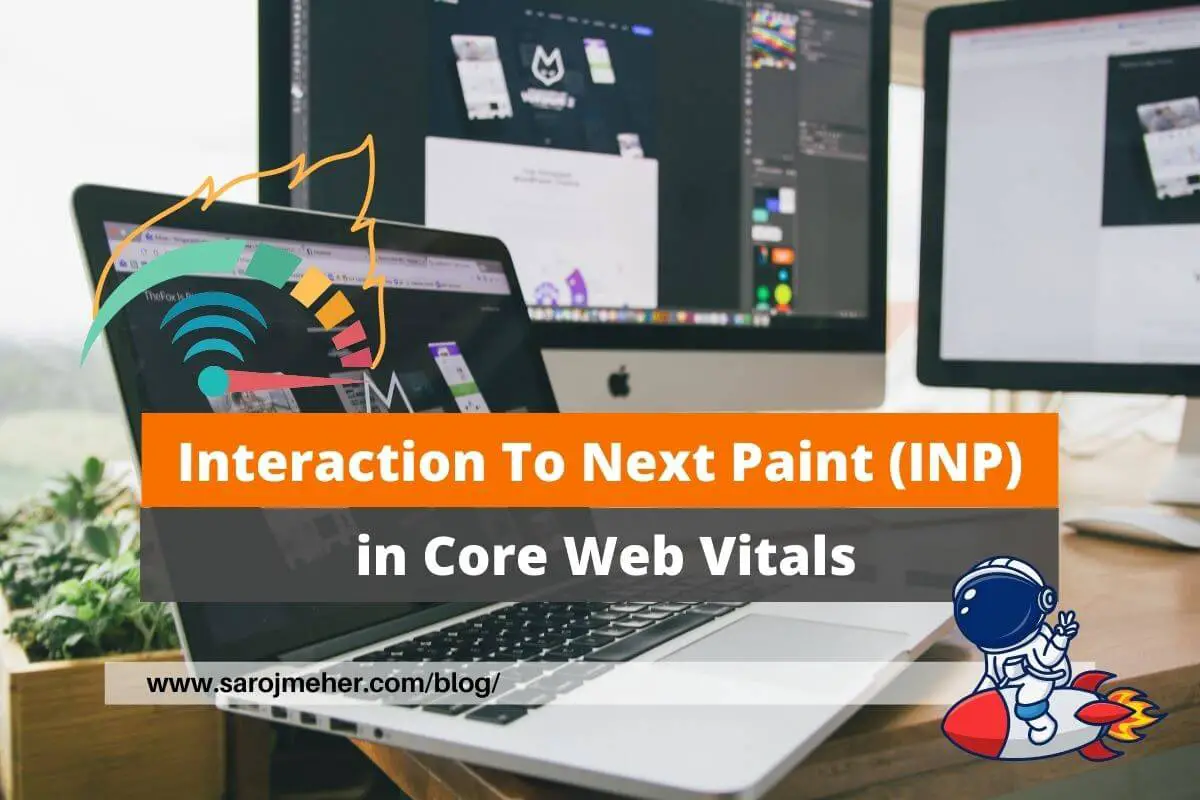Understanding Interaction to Next Paint (INP) in Core Web Vitals
In the world of web development and user experience, Core Web Vitals have gained significant attention.
These metrics help website owners and developers assess and improve the performance and user-friendliness of their websites.
One such metric is Interaction to Next Paint (INP), which measures the time it takes for a web page to respond to user input. In this article, we will explore the concept of INP in Core Web Vitals, its significance in evaluating user experience, and strategies to optimize INP for better website performance.
What is Interaction to Next Paint (INP)?
Interaction to Next Paint (INP) is a metric that measures the time it takes for a web page to respond visually after a user interacts with it.
It specifically focuses on the time between the user’s action, such as clicking a button or tapping a link, and the resulting visual feedback on the screen.
INP aims to capture the responsiveness of a website and how quickly users perceive that their actions are being acknowledged.
Importance of INP in User Experience:
INP plays a crucial role in assessing user experience because it directly impacts how users perceive the responsiveness and interactivity of a website. When a user interacts with a webpage, they expect immediate feedback to confirm that their action has been registered.
A slow INP can lead to frustration and a perception of unresponsiveness, negatively impacting user satisfaction and engagement.
In contrast, a fast INP provides a smooth and responsive user experience, enhancing overall satisfaction and encouraging users to interact more actively with the website.
Optimizing INP for Better Performance:
To optimize INP and improve website performance, consider the following strategies:
- Minimize JavaScript Execution Time: JavaScript execution can significantly impact INP. Minimize and optimize JavaScript code to reduce execution time, making the website more responsive. Remove any unnecessary scripts and optimize the critical rendering path to prioritize essential scripts.
- Use Idle Time for Non-Critical Tasks: Utilize idle time to perform non-critical tasks, such as prefetching or preloading resources. By completing these tasks during idle periods, you can avoid delaying the response to user interactions and improve the perceived responsiveness of the website.
- Optimize Image Loading: Large image files can slow down INP. Compress and optimize images to reduce their file size without compromising quality. Consider using modern image formats, lazy loading techniques, or responsive image solutions to deliver images efficiently and improve overall performance.
- Prioritize Critical Resources: Prioritize loading and rendering critical resources, such as CSS and fonts, to ensure that the website appears responsive to user interactions. Use techniques like inlining critical CSS or implementing font-display to minimize the delay in displaying essential visual elements.
- Optimize Network Requests: Reduce the number of network requests by combining and minifying files, leveraging caching mechanisms, and implementing efficient resource loading strategies. This reduces the overall network latency and improves the responsiveness of the website.
- Implement Asynchronous Loading: Consider implementing asynchronous loading techniques, such as lazy loading for non-critical content or deferring non-essential JavaScript, to ensure that the initial rendering and response to user interactions are not delayed by unnecessary resources.
Monitoring and Measuring INP:
To monitor and measure INP, use tools such as Google’s PageSpeed Insights, Lighthouse, or WebPageTest.
These tools provide insights into various Core Web Vitals, including INP, and offer suggestions for improvement.
Regularly analyze these metrics to track the performance of your website and identify areas where INP can be optimized.
Does Interaction to Next Paint (INP) affect the SEO of a website?
Search engines, such as Google, consider various factors when ranking websites, and user experience is one of them.
If a website has slow load times or a poor user experience due to delays in the rendering of content, it can potentially have a negative impact on SEO rankings.
This is because search engines aim to provide the best possible experience to their users and prioritize websites that deliver fast and smooth interactions.
Does Interaction to Next Paint (INP) affect the traffic and earnings of a Website?
The interaction and engagement of visitors on a website can have an impact on traffic and potentially influence earnings.
Websites that encourage and facilitate user interaction, such as through comments, social sharing, or interactive features, can help increase visitor engagement, time spent on the site, and the likelihood of repeat visits.
This can lead to higher traffic as visitors find the content valuable and share it with others, potentially attracting new users.
The increased traffic can positively influence website earnings, especially for websites that generate revenue through advertising or affiliate programs.
Higher traffic numbers can attract more advertisers and increase the likelihood of generating ad impressions or clicks.
Additionally, engaging content and user interactions can also contribute to higher conversion rates for sales or other monetization strategies.
Conclusion:
Interaction to Next Paint (INP) is a crucial metric in Core Web Vitals that measures the responsiveness of a website to user interactions.
Optimizing INP is essential for providing a seamless and interactive user experience. By minimizing JavaScript execution time, leveraging idle time for non-critical tasks, optimizing image loading, prioritizing critical resources, optimizing network requests, and implementing asynchronous loading techniques, website owners and developers can improve INP and enhance the overall performance of their websites.
Prioritizing user experience and monitoring Core Web Vitals, including INP, is a step toward creating websites that are more responsive, engaging, and user-friendly.
FAQs on Interaction to Next Paint (INP)
1. What is Interaction to Next Paint (INP) in Core Web Vitals?
Interaction to Next Paint (INP) is a metric included in Core Web Vitals, which is a set of user experience metrics that measure website performance. INP specifically focuses on measuring the time it takes for a webpage to become responsive to user interactions after the initial page load.
2. How is Interaction to Next Paint (INP) calculated?
INP is calculated by measuring the time from when a user first interacts with the page (e.g., clicks a button, selects a menu) to when the browser is able to respond with a visual feedback, such as highlighting the clicked element or displaying a loading spinner. It provides insights into how quickly a webpage becomes interactive for users.
3. Why is Interaction to Next Paint (INP) important?
INP is important because it reflects the responsiveness and interactivity of a website. Users expect quick and smooth interactions when navigating a webpage. A fast INP contributes to a positive user experience, while a slow INP can lead to frustration and potentially impact engagement and conversions.
4. How does a slow Interaction to Next Paint (INP) affect user experience?
A slow INP can have negative effects on user experience. When users have to wait too long for the webpage to respond to their interactions, it may create a perception of unresponsiveness or lag. This can lead to frustration, increased bounce rates, and lower user engagement with the website.
5. What factors can influence Interaction to Next Paint (INP)?
Several factors can impact INP, including the complexity of the webpage’s JavaScript code, the efficiency of event handling and rendering processes, and the performance of the user’s device and browser. Optimizing these aspects can help improve the INP and overall user experience.
6. How can website owners optimize Interaction to Next Paint (INP)?
Website owners can optimize INP by employing various techniques, such as:
- Optimizing JavaScript code to reduce execution time and ensure efficient event handling.
- Prioritizing critical tasks and deferring non-essential ones to improve responsiveness.
- Using browser caching and minimizing network requests to reduce loading times.
- Employing code splitting and lazy loading techniques to load only necessary resources.
- Monitoring and optimizing server response times to reduce delays in processing user interactions.
7. Does Interaction to Next Paint (INP) impact search engine rankings?
While INP is not a direct ranking factor for search engines, Core Web Vitals, including INP, are considered important indicators of website quality and user experience. Search engines like Google have emphasized the importance of user-centric metrics, and websites that provide better user experiences may indirectly benefit from improved search visibility.
8. Can Interaction to Next Paint (INP) be measured using tools?
Yes, there are various web performance monitoring and measurement tools that can help measure INP and other Core Web Vitals. Tools like Google’s PageSpeed Insights, Lighthouse, and various other performance monitoring platforms provide insights into INP values and suggestions for optimization.
9. What are the other Core Web Vitals metrics besides Interaction to Next Paint (INP)?
Core Web Vitals include other important metrics:
- Largest Contentful Paint (LCP): Measures the time it takes for the largest visible element to render on the page.
- First Input Delay (FID): Measures the delay between a user’s first interaction and the browser’s response. These metrics, along with INP, collectively help evaluate the overall user experience of a webpage.
10. Can Interaction to Next Paint (INP) be improved after a webpage has loaded?
Improving INP after a webpage has loaded can be challenging. It often requires optimizing the underlying architecture, minimizing JavaScript execution time, and streamlining event handling processes. It is generally more effective to focus on optimizing these aspects during the development and optimization phases of the website.








